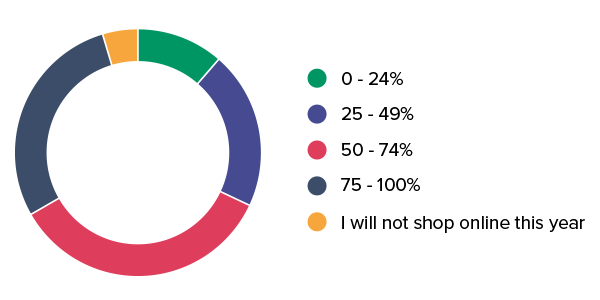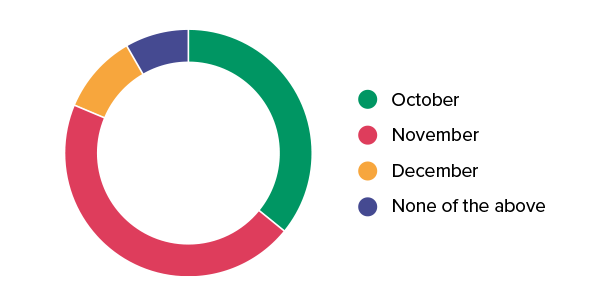

As we approach the holiday season, there is still so much uncertainty around exactly what holiday shopping will look like this year. Last year, e-commerce sales grew 13.2% during the holidays— along with record-breaking Cyber Monday sales. Following recent increases in e-commerce spending, the retail industry can anticipate an even larger boost for the 2020 season. At the beginning of the COVID-19 pandemic, e-commerce sales initially grew 40% across the 1.1K retailers and brands we work with— even reaching Black Friday levels of online sales volume during the summer months.
To better understand consumers’ pain points and priorities, we conducted research to unveil exactly how consumers plan to tackle their holiday shopping this year. Overall, we found that 94% of respondents plan to shop online for a portion of holiday gifts— with 64% planning to purchase at least half of their gifts online. Holiday spending is expected to stay consistent, with 58% of consumers planning to spend the same amount that they did last year; however, we expect buying patterns to differ from previous seasons.
Among the findings: the holiday season is starting earlier this year, shoppers are still turning to their trusted channels for timely deals and promotions, and mobile engagement is on the rise across brands and retailers. As retailers and brands prepare for the most online holiday season yet, here’s what they need to know:

This year, nearly two thirds of consumers plan to begin holiday shopping well before Thanksgiving— with 35% beginning as early as October. Plus, nearly half (44%) of consumers will start shopping earlier than last year.
Outside of annual shopping events and promotions, consumers are also factoring shipping and delivery timelines into their holiday shopping schedules. As a result of the COVID-19 pandemic, supply chains are still struggling to return to normal, and the unexpected e-commerce boom overwhelmed many fulfillment and delivery companies. Now, 65% of consumers anticipate shipping delays and will therefore begin shopping earlier. During the busiest shopping season of the year, we can expect to see an increase in shipping rates as well as longer wait times. As more and more families forgo traveling this holiday season, they will rely on online shopping and shipping gifts directly to recipients— further increasing parcel volumes and delays.
As holiday shopping ramps up in the coming weeks, retailers and brands should be overly communicative about sales and promotions, as well as seasonal products and services that may be of interest to consumers. They should also be transparent about expected delays to ensure a seamless customer experience.

While Black Friday and Cyber Monday usually kick off the formal holiday shopping season, many retailers are looking outside of the traditional BFCM window to encourage holiday spending. Retailers and e-commerce giants are already taking note: Starting with Amazon reportedly postponing its annual Prime Day to early October, retailers across the industry will work to engage with customers and capture revenue as early as they can.
Black Friday and Cyber Monday will remain the largest shopping events of the holiday season, but the traditional spikes in revenue won’t be as dramatic as previous years. We’ll also see retailers doubling down on online sales to compensate for reduced in-store traffic and sales that they could previously count on from Black Friday and Cyber Monday traffic.
With holiday promotions getting an early start, and still running through Thanksgiving, the competition to stand out and secure consumers’ dollars will be more fierce than ever before. To capture as much revenue as possible, retailers will need to examine local and curbside pickup. In fact, following its increase in popularity during quarantines, 40% of respondents plan to use contactless options like curbside pick-up for their gifts.

With 5 billion people owning smartphones globally, the best way that retailers can reach consumers is to meet them where they are— on their phones. Today, 60% of consumers provide their mobile number to retailers or brands— with one in five (21%) shoppers sharing their number at a greater frequency than they did last year. Whether it’s through email, text messages, paid search or social, or even push notifications on branded apps, retailers have several touchpoints to connect with shoppers.
Right now, more than two thirds of respondents (67%) rely on email as the most common channel to find deals and promotions— followed by retailer and brand websites (50%), direct mail coupons (47%), and social media posts (45%). Retailers who can better segment customers and personalize communications will enter 2021 with a stronger footing,
Mobile-first channels like SMS and push notifications can help to drive urgency with actionable and personalized messages about flash sales, inventory alerts, and timely updates on local brick-and-mortar locations. Because customers need to opt-into these communications, they have already sought out the information retailers are providing.
One of the best uses for mobile engagement is to share new and exclusive deals with subscribers. Almost one in three consumers (30%) find their holiday deals and promotions through text. This number will continue to rise: at Listrak, SMS sends during the holiday 2019 season resulted in a 3.4X increase in revenue per SMS message sent over email. Email remains, by far, the most important way consumers look for news and promotions from retailers and brands; however, there is a growing opportunity for retailers to see exponential growth from SMS marketing.
It’s not clear exactly what this holiday season will bring, but we do know that consumers are thinking about their holiday shopping differently. While spending budgets haven’t significantly changed in the last year, how consumers are shopping has evolved: earlier start dates, more online shopping, new expectations for BFCM, and an increase in mobile engagement are all redefining the holiday 2020 season. To make the most of the busiest and most lucrative time of the year, retailers need to listen and act on consumers' concerns and priorities— it will determine who comes out for the holidays with a sustainable business for 2021.
*The holiday shopping survey study was fielded by Listrak via Survey Monkey from September 9-10, 2020 among a national sample of more than 2,000 adults. The interviews were conducted online, and the data were weighted to approximate a target sample of adults based on age, gender, household income, and region.











